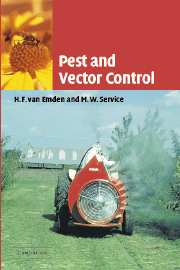Book contents
- Frontmatter
- Contents
- Preface
- 1 Man and insects
- 2 The causes of pest and vectored disease outbreaks
- 3 Insecticides and their formulation
- 4 Application of insecticides
- 5 Problems with insecticides
- 6 Environmental/cultural control
- 7 Biological control
- 8 Insect pathogens
- 9 Genetic control
- 10 Pheromones
- 11 Plant and host resistance
- 12 Other control measures and related topics
- 13 Pest and vector management
- Appendix of names of some chemicals and microbials used as pesticides
- References
- Index
13 - Pest and vector management
Published online by Cambridge University Press: 03 December 2009
- Frontmatter
- Contents
- Preface
- 1 Man and insects
- 2 The causes of pest and vectored disease outbreaks
- 3 Insecticides and their formulation
- 4 Application of insecticides
- 5 Problems with insecticides
- 6 Environmental/cultural control
- 7 Biological control
- 8 Insect pathogens
- 9 Genetic control
- 10 Pheromones
- 11 Plant and host resistance
- 12 Other control measures and related topics
- 13 Pest and vector management
- Appendix of names of some chemicals and microbials used as pesticides
- References
- Index
Summary
Introduction
As was mentioned in Chapter 5, man has already found situations where the insecticide ‘road’ has run out. Many of the available insecticides failed in the middle and late 1950s because of tolerant pest strains on cotton in Peru, on lucerne in California and on chrysanthemums in glasshouses in Britain, and already some medical/veterinary pests were becoming resistant. In her controversial book Silent Spring, Rachel Carson (1962) had advocated that man must choose between chemical and biological control; mankind was ‘standing at a fork’ of the ways. The first sentence of her final chapter (‘The Other Road’) in fact begins with the sentence ‘We stand now where two roads diverge’. In the light of what was already happening at that time with lucerne in California, and what has happened since elsewhere, the sentence stands out as perhaps the most interestingly misleading statement ever made about pest control.
It is a useful exercise to look at the above three famous examples of failure of insecticidal control against crop pests in the 1950s and to consider the principles involved in the solutions in the light of that sentence of Rachel Carson's, ‘We stand now where two roads diverge’.
It is worth noting that, at about the time of Carson's book, the authority for the registration of pesticides in the USA was taken from the Department of Agriculture and placed in a newly formed Environmental Protection Agency (EPA), and one of the first actions was to suspend usage of DDT in the USA.
- Type
- Chapter
- Information
- Pest and Vector Control , pp. 271 - 319Publisher: Cambridge University PressPrint publication year: 2004
- 1
- Cited by



